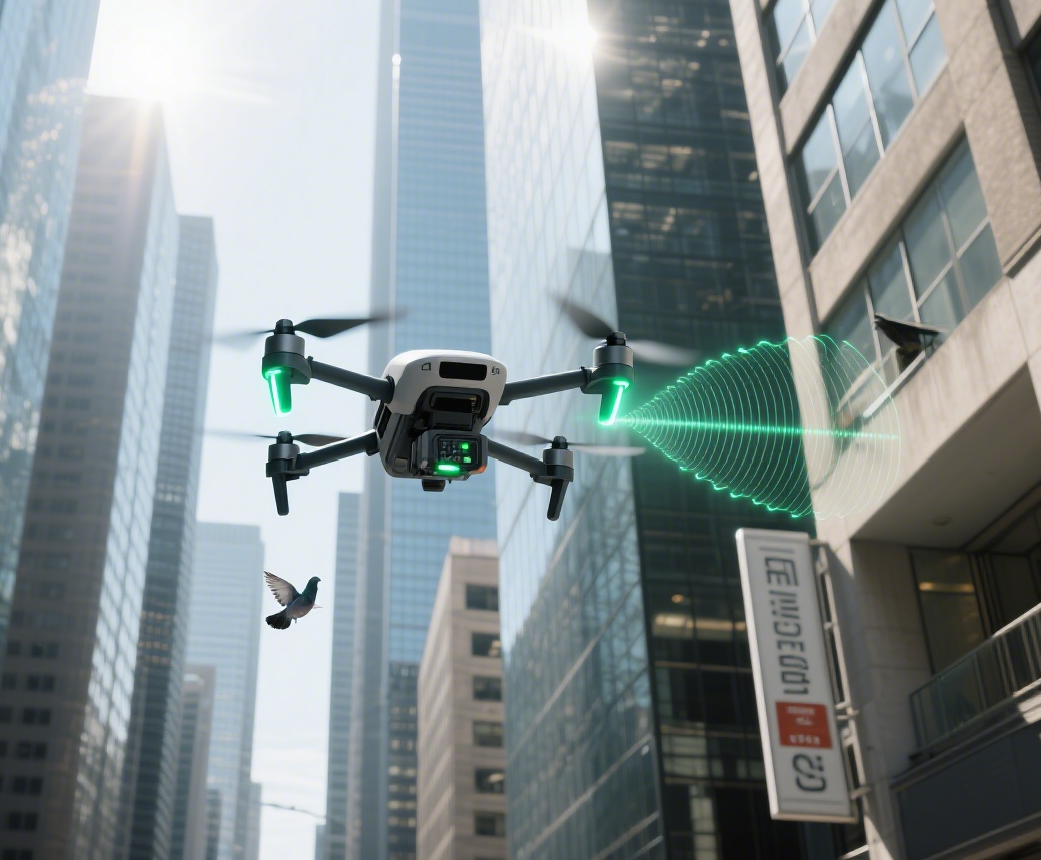Introduction: Can Drones Navigate Dense Cities Safely?
Flying a drone in dense urban areas presents one of the most demanding operational environments. High-rise buildings, narrow alleys, wires, poles, and vehicles create a constantly evolving obstacle landscape. Operators often ask:
“Can a millimeter-wave radar system reliably detect obstacles in such complex urban settings without fail?”
This question is critical for UAV applications like logistics, inspection, and surveillance. Understanding reliability requires analyzing both sensor performance and real-world operational constraints.
Urban Environment Challenges
-
High Obstacle Density – Drones must navigate tightly packed infrastructure, including signage, wires, poles, and construction materials. For small UAVs flying at 5–15 m/s, even minor miscalculations can result in collisions.
-
Multipath Radar Interference – Reflections from glass, metal, and concrete can generate false echoes. Without proper signal processing, radar data may mislead the autopilot.
-
Environmental Conditions – Cameras and LiDAR are affected by low light, glare, fog, or dust. Optical sensors can produce incomplete data, whereas mmWave radar penetrates these conditions reliably.
-
Dynamic Obstacles – Pedestrians, vehicles, and moving construction equipment introduce unpredictability, requiring sensors with rapid update rates and low reaction latency.
Operators often find that relying solely on cameras or LiDAR increases collision risk in urban settings. This is where mmWave radar provides a significant reliability advantage.
Millimeter-Wave Radar Technical Advantages
Linpowave mmWave radar offers the following features critical for urban UAV reliability:
-
High Frequency (77–81 GHz) – Provides high-resolution measurements with ±5 cm accuracy over 0.4–200 m.
-
Compact and Lightweight – 70×50×5.5 mm, 15 g; ideal for small UAVs without compromising maneuverability.
-
Low Power Consumption – Average 4 W, minimizing impact on flight endurance.
-
Fast Scan Rate – 50–100 Hz update frequency ensures real-time obstacle detection.
-
Multi-Target Tracking – Simultaneous detection of static and moving obstacles reduces collision risk.
-
All-Weather Robustness – Effective in rain, fog, dust, and low light, outperforming optical sensors in challenging conditions.
These advantages make mmWave radar highly suitable for urban UAVs where reliability is mission-critical.
Quantitative Reliability Analysis
Field tests and internal Linpowave data indicate:
-
Detection Range: 0.4–200 m
-
Reaction Time: ≤50 ms
-
False Positive Rate: <3% in dense urban scenarios
-
Missed Detection Rate: <1% for obstacles larger than 10 cm
Case Study: A 10 m/s UAV navigating a narrow alley successfully detected wires, poles, and vehicles up to 50 m ahead. The radar allowed sufficient reaction time for avoidance maneuvers, demonstrating that mmWave radar can reliably manage both static and dynamic obstacles in urban corridors.
In comparison, vision-based sensors often fail to detect reflective or dark surfaces, and LiDAR performance may degrade under fog or dust.
Deployment and Optimization Strategies
To maximize reliability, UAV operators can adopt practical strategies:
-
Sensor Fusion – Integrating radar with cameras or LiDAR provides redundancy. Linpowave technology enables radar to act as a safety layer in low visibility.
-
Dynamic Thresholding – Adjust detection thresholds according to flight speed and urban density to reduce false positives.
-
Selective Scanning – Focus on high-risk areas; reduces computational load while maintaining obstacle coverage.
-
Mounting Optimization – Flush or angled mounting minimizes blind spots, ensuring full field-of-view coverage.
-
Software Filtering & Target Tracking – Apply Kalman filtering or predictive algorithms to distinguish real obstacles from reflections, reducing unnecessary evasive maneuvers.
Applying these methods ensures high detection reliability while keeping power and weight impact minimal.
Real-World Benefits and Economic Value
-
Reduced Collision Risks – Fewer accidents save on UAV repair costs and downtime.
-
Expanded Operational Zones – Reliable detection allows drones to safely operate in urban corridors previously considered too risky.
-
Improved Mission Success Rate – Essential for logistics, inspection, and surveillance tasks.
For instance, in urban package delivery, avoiding a single collision can save thousands of dollars in hardware and operational downtime. The minimal energy cost of 4 W and lightweight 15 g radar modules is negligible compared to the potential financial losses from a collision.
Conclusion
Millimeter-wave radar offers high reliability for urban UAV obstacle avoidance, combining:
-
All-weather and all-light performance
-
Lightweight and compact design (15 g, 70×50×5.5 mm)
-
Rapid update rate and multi-target detection
When deployed with sensor fusion, dynamic thresholding, selective scanning, and optimized mounting, Linpowave mmWave radar ensures safe UAV flights in dense urban environments. Operators can achieve reliable obstacle detection, protect their assets, and maintain mission efficiency without compromising flight endurance.



